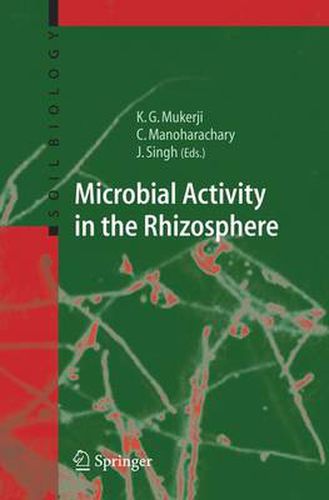Readings Newsletter
Become a Readings Member to make your shopping experience even easier.
Sign in or sign up for free!
You’re not far away from qualifying for FREE standard shipping within Australia
You’ve qualified for FREE standard shipping within Australia
The cart is loading…






This title is printed to order. This book may have been self-published. If so, we cannot guarantee the quality of the content. In the main most books will have gone through the editing process however some may not. We therefore suggest that you be aware of this before ordering this book. If in doubt check either the author or publisher’s details as we are unable to accept any returns unless they are faulty. Please contact us if you have any questions.
The rhizosphere is a very complex environment in which the effects of the plant on soil microorganisms and the effects of the microorganisms on the plant are interacting and are interdependent. Plant root exudates and breakdownproducts attract microbes and feed them and, in turn, the plants often bene?t from the microbes. Interactions among microorg- ismsandplantrootsareessentialfornutritionalrequirementsoftheplant. Plant growth, development and productivity are largely dependent on the soil environment in the root region rhizosphere. The new techniques of studying the rhizosphere enables us to get a much better understanding of the dynamics of the rhizosphere population, such rhizosphere studies beingofinteresttoagriculturists,soilbiologists,chemists,microbiologists andmolecularbiologists. The rhizosphere microbes in?uence the root environment in several ways. They may change the oxidation-reduction potential, in?uence the availabilityofmoistureandnutrients,producegrowthinhibitingorgrowth promoting substances in the form of exudates, provide competition and possiblyinducemanyothereffects.Mycorrhizalassociationsarebene?cial in mineral uptake and in increasing root surface area for effective ion absorption. Antagonism,competitionandsynergisminsoilandtherhizoplane(r- zosphere) are the most important microbial interactions to consider in the study of rhizosphere biology. With the growing information on the production of growth regulators, competitiveness of the microbes in the rhizosphere, microsymbionts, and other factors, their effect upon plant growth will become more evident. Experiments on the introduction of microbes or their products in the rhizosphere will help to improve our understandingofthebiologyoftherhizosphere.
$9.00 standard shipping within Australia
FREE standard shipping within Australia for orders over $100.00
Express & International shipping calculated at checkout
This title is printed to order. This book may have been self-published. If so, we cannot guarantee the quality of the content. In the main most books will have gone through the editing process however some may not. We therefore suggest that you be aware of this before ordering this book. If in doubt check either the author or publisher’s details as we are unable to accept any returns unless they are faulty. Please contact us if you have any questions.
The rhizosphere is a very complex environment in which the effects of the plant on soil microorganisms and the effects of the microorganisms on the plant are interacting and are interdependent. Plant root exudates and breakdownproducts attract microbes and feed them and, in turn, the plants often bene?t from the microbes. Interactions among microorg- ismsandplantrootsareessentialfornutritionalrequirementsoftheplant. Plant growth, development and productivity are largely dependent on the soil environment in the root region rhizosphere. The new techniques of studying the rhizosphere enables us to get a much better understanding of the dynamics of the rhizosphere population, such rhizosphere studies beingofinteresttoagriculturists,soilbiologists,chemists,microbiologists andmolecularbiologists. The rhizosphere microbes in?uence the root environment in several ways. They may change the oxidation-reduction potential, in?uence the availabilityofmoistureandnutrients,producegrowthinhibitingorgrowth promoting substances in the form of exudates, provide competition and possiblyinducemanyothereffects.Mycorrhizalassociationsarebene?cial in mineral uptake and in increasing root surface area for effective ion absorption. Antagonism,competitionandsynergisminsoilandtherhizoplane(r- zosphere) are the most important microbial interactions to consider in the study of rhizosphere biology. With the growing information on the production of growth regulators, competitiveness of the microbes in the rhizosphere, microsymbionts, and other factors, their effect upon plant growth will become more evident. Experiments on the introduction of microbes or their products in the rhizosphere will help to improve our understandingofthebiologyoftherhizosphere.